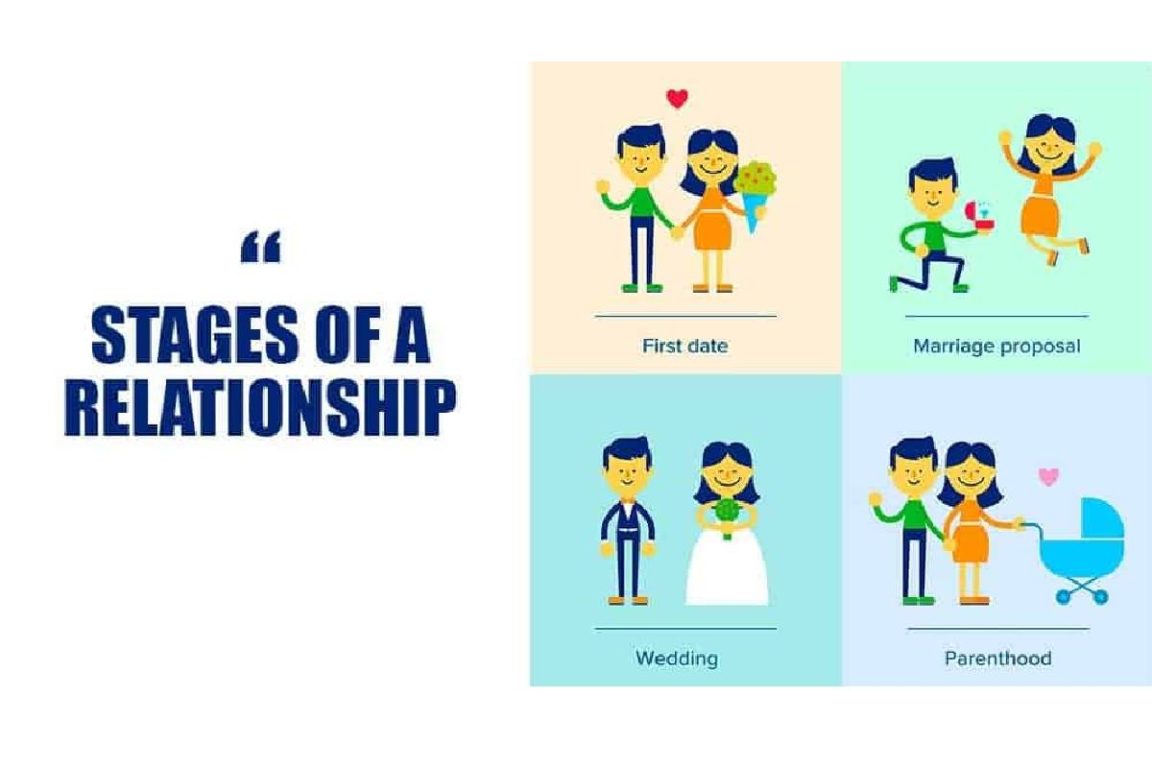Phases of a Relationship – It is easy to fall in love, but it is tough to maintain relationships—despite what Hollywood tries to sell us. Like whatever else in life is worth having, relationships take work. Some couples weather the storms that certainly arise, while others sense them separately.
There is no instruction manual when it is a matter of coupling. Do you Remember that old playground chant: First comes love, then comes the wedding, then comes so and so and a baby carriage? If only it were that humble. While some couples follow this traditional path, many people do not. Fewer couples are getting married, some have children before marriage, and some choose not to have children. Every relationship, like every individual, is exclusive.
Irrespective of the path one chooses when it comes to romantic relationships—whether down the aisle or across continents—the critical stages of love and attachment remain the same. A couple’s ability to navigate these stages is often the key to their relationship satisfaction.
Neuroscientists and “love experts” have outlined four stages of a relationship. They go from falling in love to existing happily ever after (for a meanwhile). Here are the stages they’ve found and ways to navigate each successfully.
Phases of a Relationship – 1. The Euphoric Stage
For the past several decades, Helen Fisher, PhD, neuroscientist and Elder Research Fellow at the Kinsey Institute, and Lucy Brown, PhD, Clinical Lecturer in Clinical neurology at the Einstein University of Medicine in New York City, has been pursuing the function of the brain of people in love, from the initial to the later stages.
Brown explains, “In the initial part of a relationship—the falling in love stage—the additional person is the centre of your life. You excuse all in these primary stages. The other person has blundered, and you see them, but it doesn’t make a difference. Maybe they leave their unwashed dishes in the sink, but they make you happy at least daily, so it’s okay. Good things overshadow the negative here.”
One of the most important findings in brain planning studies (considered the key factor in relationship achievement) involves what Brown refers to as the interruption of negative judgment. “In this initial stage, many people show a reduction in activity in the prefrontal cerebral cortex, which is the portion of the brain that has to do with the adverse verdict of people.”
In other words, the lengthier a couple can uphold the suspension of negative judgment to each other, the better their chances of relationship achievement. When they followed up with contestants, the researchers found that the couples who had remained together for three years or further had the most reduced activity in this part of the brain.
Phases of a Relationship – How Long Will It Last?
When did the romantic phase last? Studies have valued that the euphoric stage can last from six months to two years. While a small portion of the people (around 15% to 30%) say they remain in love and that it feels like the first six months—even after 10 or 15 years.
Brown explains, “We don’t recognize why this is. I don’t think it’s as if they have found their soulmates. I think it’s the person. Some people have an easier time rejuvenation in the initial stages. Not to say the remaining of us can’t.”
For the overall population, the intoxication of new love will ultimately morph into the next stage: early attachment.
2. The Early Attachment Stage

In the initial stage of euphoric love, attraction and the activation of the recompense system take over. In Fisher and Brown’s studies, the scans of the brain of couples in the initial stages of love show high levels of dopamine, the chemical that activates the reward system by starting a deep rush of pleasure.
The study’s authors wrote that these high dopamine levels have the same effect on the brain as cocaine. In this following stage, the more evolved part of the brain starts to take over, with the ventral pallidum (the area of the brain related to feelings of attachment, and the attachment hormones, vasopressin, and oxytocin—sometimes mentioned as “the love hormone”).
You know when you’ve reached the early add-on stage when, as per Brown, “You can sleep! You’re not thinking of your partner 24 hours a day. It’s easier to do other activities in your life.”
Couples that had remained wedded for at least one year describe love differently. “It’s richer, deeper; it knows them better,” says Brown. “Memories have been united—both positive and negative—you’ve gone through some problems, and you’ve developed a strong attachment.”
3. The Crisis Stage
The third stage is often the make-or-break point for relationships. What occurs at this stage is crucial to what comes subsequent. Brown mentions this as the “seven-year or else five-year itch.
“Nearly every relationship has a point apart phase,” says Brown. “Either you will keep wandering, or you will come back together. You need a disaster to get over and to be capable of talking about it together—you’ve both grown and changed.”
For some couples, having kids will make their relationship strong or cause enough stress to make the relationship fall apart. If a couple can successfully overcome a crisis, they will move on to the subsequent stage: deep bonding. The 6 Best Online Marriage Counselling Plans
4. The Deep Bonding Stage
The deep bonding stage is the calm after the storm. By this point, a couple is well aware of each other; the couple has been through the inevitable ups and downs, knows that they can handle the crises, and likely make a strategy for managing future situations.
When describing this relationship stage, Brown reiterates the term “calm.” “When couples have been together for several years. It’s just very, very calm. And it’s secure.” The deep attachment stage can remain for a long time. If you’re fortunate, it can stay throughout your life.
To keep it Going
How can we keep love going? According to researchers, originality is one of the most efficient ways of keeping the spark alive. Studies that have tracked couples for years have found that performing new, exciting, and interesting activities together has huge benefits for relationships.4
Dr Art Aron, one of Fisher besides Brown’s main agents, and his wife, Dr Elaine Aron, create the “Self Expansion Model” that offers insight into the initial stages of love. It partially clarifies why the first few months of a new relationship feel so strong.
“When you enter a relationship, you rise as who you are. You consider and share your partner’s viewpoint on the world besides your own, their social status, and their resources. The benefits of new and challenging pieces of knowledge together are huge. And they last.”
Phases of a Relationship – Conclusion
Phases of a Relationship – These relationship stages are not a line method; they are more like a spiral, turning upwards. One relationship stage will control your partnership at any given time till you learn that stage’s lesson. You hold the lessons you learned at each previous stage and bring them forward as you grow up together.
You’ll keep going back to the Power Struggle stage until you know to solve the fight in a way that builds your partner up instead of tearing them down. Establish a reliable emotional connection, repair broken trust, heal old hurt, accept your partner’s flaws, and appreciate how they differ.

